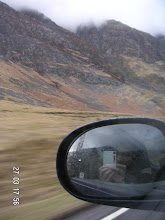Within the mammoth grounds of the National Chiang Kai Shek Memorial Park stands the National Theatre and the National Concert Hall and at the far end, a white building with blue octagonal roof is the Memorial Hall. Within the hall is a large sculpture of a seated Chiang Kai Shek, though it was closed for renovations during my visit.
Chiang Kai Shek played a large part in Taiwan's history. Towards the end of the Chinese Civil War against the Mao-led Communists, Chiang and his Nationalist Party, Kuomingtang (KMT) retreats to Taiwan in 1949. His retreat meant a temporal move of the goverment of the Republic of China (ROC) which was first established in 1912 by his mentor Dr Sun Yat Sen. Here he claims his government to be the rightful sovereign over all of China and Taipei its provisional capital. In 1949 Mao establishes the People's Republic of China, in China. Chiang and the ROC has effectively been ousted.
Chiang was elected as the President of the ROC in 1948 and remained in the position until his death in 1975. Taiwan under the Chiang and the KMT was a single-party state. In fact, Taiwan is placed under martial law until 1987 and this entire period is known as 'White Terror', suppression of all political dissent against the KMT. Actual or even perceived dissention was punishable by imprisonment or execution. Even something as trivial as the local Taiwanese dialect is banned and Mandarin, favoured by mainlanders and KMT is enforced. I clearly recall my childhood as a first grader, in 1984, discussing with my friends in know-all tones that speaking in Taiwanese is not allowed.
The Chiang Kai Shek Memorial Hall was officially opened in 1980. It is an impressive building, its blue and white colours and traditional shape stands proudly in the large open square. Under Chiang's rule, Taiwan under goes massive developments and throughout the 60s and into the 70s grows an economy of envy, earning a place as one of the "Four Asian Tigers".
With the Cold War in place during this time, Chiang is regarded by the West as a legitimate and respected leader of China (which included the island of Taiwan) even though the ROC had no actual control whatsoever with anything that occurred on the mainland. One has to remember that Chiang led China into WWII as an Allied force and was the one of the four most powerful nations at that time along with the USA, UK and France, collectively known as the "Four Policemen". At the end of the second world war, Chiang was the head of a country that became a founding member of the United Nations and also a permanent member of the UN Security Council.
With the lift of martial law in 1987, criticism of Chiang from the people of Taiwan is finally bubbling forth. Many monuments, statues, streets named after or in honour of Chiang are being gradually removed or replaced. In fact in 2007, President Chen Shui Bian of the Democratic Progressive Party announced that the National Chiang Kai Shek Memorial Hall to be renamed the National Taiwan Democracy Memorial Hall. However supporters of the original name (predominately KMT members) objected to the change and now due to political scuffling and legal tug-o-war the old name is still technically the correct name but none from either side of the political fence likes to refer to it as such. Kinda like Taiwan's own political/legal status. I mean ROC.
Technically Taiwan does not exist as a county. Doesn't that just blow your mind?


L: Impressive gates to the Memorial Park; R: CKS Memorial Hall, large and looming in the distance. High school kids in the foreground.


L: Troops in prep for the "Double 10 Day" parade (or Independence Day, held on the 10th of October), in front of the National Concert Hall; R: The National Concert Hall, under renovations for the celebrations.


L: Front view of the National Concert Hall with troops parading ant-like in front; R: Sweaty soldiers guarding rifles during a break in their practice.
I mentioned earlier that Dr Sun Yat Sen was a mentor to Chiang Kai Shek. He is considered by both the People's Republic of China and the Republic of China as the "Father of the Fatherland". Dr Sun's influence culminated in the overthrow of the Qing Dynasty in 1911, the last dynastic family that will ever rule China.
Inside the memorial hall which is topped by a wonderful golden roof, is a large statue of Dr Sun, guarded by two military personnel at all times. There is a sign in front of the statue asking visitors to bow to the statue as a sign of respect. I did not, as one is under no obligation. But I did see a Taiwanese man and his wife bowing deeply upon entering.
The memorial hall sits in a less austere sounds and its verandah on the shady side that day sat many old men playing Chinese chess with other old men onlookers.


L: Old and new - SYS Memorial Hall and Taipei 101; R: Side view of SYS Memorial Hall.


L: The front of SYS Memorial Hall; R: Mosaic on the foot path.


L: Sign declaring new name for CKS Memorial Hall, technically not correct due to legal and political game play; R: The verandah of SYS Memorial Hall.


L: A Chinese chess game in session, one of many on the day; R: Sign in front of Dr Sun's statue requesting visitors to salute. Bowing is acceptable.

No comments:
Post a Comment